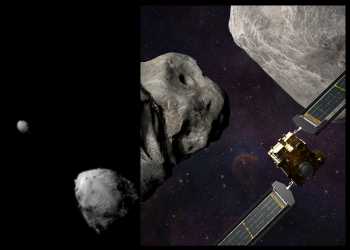
NASA’s Spacecraft Successfully Crashes On Asteroid
Monday, NASA successfully executed an experimental mission to deviate an earth-bound sizeable space rock to prevent it from hitting the planet.
At 7:14 p.m. ET, mission control at the Johns Hopkins Applied Physics Laboratory (APL) in Laurel, Maryland, announced that the U.S. space agency’s Double Asteroid Redirection Test (DART) spacecraft crashed into Dimorphos, the asteroid moonlet of Didymos.
Dimorphos, a small body just 530 feet in diameter, orbits a larger, 2,560-foot asteroid called Didymos. Neither asteroid poses a threat to Earth.
The mission’s one-way trip confirmed that NASA can successfully navigate a spacecraft to intentionally collide with an asteroid to deflect it, a technique known as kinetic impact.
The investigation team will now observe Dimorphos using ground-based telescopes to confirm that DART’s impact altered the asteroid’s orbit around Didymos. Researchers expect the impact to shorten Dimorphos’ orbit by about 1 percent, or roughly 10 minutes.
Precisely measuring how much the asteroid was deflected is one of the primary purposes of the full-scale test.
“Planetary Defense is a globally unifying effort that affects everyone living on Earth,” said Thomas Zurbuchen, associate administrator for the Science Mission Directorate at NASA Headquarters in Washington.
“Now we know we can aim a spacecraft with the precision needed to impact even a small body in space. Just a small change in its speed is all we need to make a significant difference in the path an asteroid travels,” he added.
The spacecraft’s sole instrument, the Didymos Reconnaissance and Asteroid Camera for Optical navigation (DRACO), together with a sophisticated guidance, navigation and control system that works in tandem with Small-body Maneuvering Autonomous Real Time Navigation (SMART Nav) algorithms, enabled DART to identify and distinguish between the two asteroids, targeting the smaller body.
These systems guided the 1,260-pound box-shaped spacecraft through the final 56,000 miles of space into Dimorphos, intentionally crashing into it at a speed of 14,000 miles per hour to slightly slow the asteroid’s orbital speed. DRACO’s final images, obtained by the spacecraft seconds before impact, revealed the surface of Dimorphos in close-up detail.
The images of DART’s impact and of the asteroid’s resulting cloud of ejected matter are intended to help researchers better characterize the effectiveness of kinetic impact in deflecting an asteroid. Images will be downlinked to Earth one by one in the coming weeks NASA said.
Over the coming weeks, researchers will precisely measure Dimorphos’ orbital change to determine how effectively DART deflected the asteroid. The results will help validate and improve scientific computer models critical to predicting the effectiveness of this technique as a reliable method for asteroid deflection.
Dr Lori Glaze, the director of planetary science at NASA, sounded optimistic of the experiment’s success.
“We’re embarking on a new era of humankind, an era in which we potentially have the capability to protect ourselves from something like a dangerous hazardous asteroid impact. What an amazing thing; we’ve never had that capability before,” she told reporters.
Roughly four years from now, the European Space Agency’s Hera project will conduct detailed surveys of both Dimorphos and Didymos, with a particular focus on the crater left by DART’s collision and a precise measurement of Dimorphos’ mass, NASA said in a press release.
Source: Read Full Article